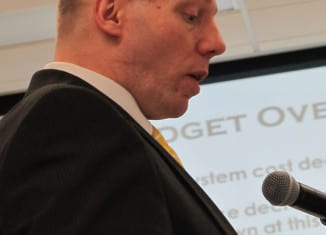Three Village school district talks budget
By Andrea Moore Paldy
The good news continues for the Three Village School District and its projected budget for the upcoming school year.
After whittling away programs because of financial constraints, the school district, for the first time in three years, is on the verge of bringing some back. District Superintendent for Business Services Jeff Carlson outlined this in his report.
Not only will Three Village be able to stay within the 2.93 percent cap on the tax levy increase without cuts, its administration is proposing staffing changes to restore health education in grades four through six, American Sign Language at Ward Melville High School and the Three Village Academy and full-time social workers at all elementary schools.
Gov. Andrew Cuomo’s official state aid projections, released Tuesday, slated a roughly 4.3 percent increase, which was roughly the same amount Carlson was budgeting for, he said, totalling more than $1 million as the district anticipated.
Districts have yet to learn whether their aid will include a reduction in the Gap Elimination Act (GEA), a measure that deducts money from aid packages to fund the state’s budget. Carlson said that while Long Island districts pay 21 percent of the GEA, they receive just 12 percent of state aid. Three Village’s share of the GEA is $5.2 million for the current school year.
Three Village will also see some of its expenses drop next year. One example is a $3.6 million decrease in contributions to retirement systems. Since the district is a member of a self-insured consortium of school districts, it has been able to make changes that will reduce health insurance rates by 5 percent, saving more than $1 million, Carlson said.
The district can also count on tuition revenue from non-residents attending the district’s special education programs and Three Village Academy, which brought $1.2 million to the district this year.
With the finances improving, the administration plans to balance classes in all grades and to depend less on the district’s applied fund balance, decreasing the amount used to balance the budget from about $6.5 million to between $2 million and $2.5 million, Carlson said.
Declining enrollment at the elementary level is making it possible to both balance class sizes and restructure some positions. Superintendent Cheryl Pedisich said the administration would take three full-time equivalent (FTE) classroom teachers and the two remaining teachers from the Pi enrichment program — which is ending this year — to create math and science enrichment specialists for each elementary school.
“We’ve all come to the conclusion that really enrichment should be a building-wide enrichment,” Pedisich said. “We also feel, with regard to math, that greater intervention needs to be addressed at the elementary level.”
Lower enrollment also means that the district does not have to replace retirements in special education and can increase staffing in health by .9 FTE, instead. Health, which is now only given to sixth-graders, can again be offered to students in the fourth through sixth grades. Plans also are being made to boost the social worker position by .5 FTE.
Pedisich called having full-time social workers in every elementary school “the clinical piece” that makes possible “the identification and the preventive work” necessary to complement the security and safety upgrades the district has made.
To balance classes, decrease study halls and increase electives at the junior highs and high school, there will be small increases to staffing, Pedisich said. Retirements will pay for the additions.
Departments to benefit include technology, English, foreign language, guidance, health, math, science and social studies.
The ASL class, which had many advocates during the two years it was slated for cuts, will again be offered by the foreign language department.
Due to a new state mandate, the district must also add 1.2 FTEs for English as a Second Language (ESL) teachers.
Additional clerical positions will be added and divided among junior high libraries, the Ward Melville High School office, human resources and business. Carlson said that maintenance and operations would gain three FTEs to lower overtime costs and outside contractors. There will also be additional security during the day and for evening activities, he said.
The district will restructure its current administration to create new roles without the need for additional staff, Pedisich said. Some of the positions expected to be restored include the coordinating chair for music, an assistant director for health and physical education, an assistant director for pupil personnel services, coordinating chair for junior high foreign language and district-wide ESL and an assistant director for instructional technology.
Pedisich said that the latter position is particularly important, because the schools will eventually transition to the computer-based Partnership for Assessment of Readiness for College and Careers testing.
The board will adopt the budget on April 15. The budget vote is May 19 at the district’s elementary schools.







